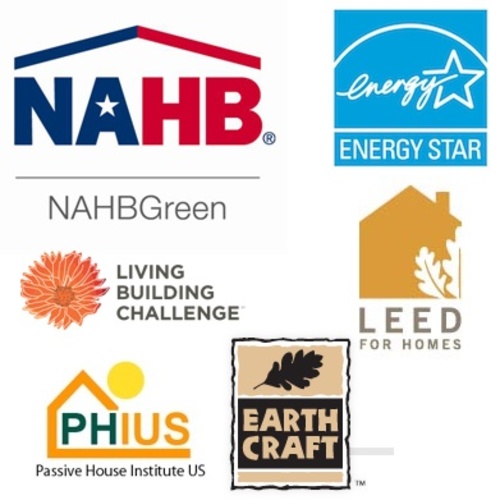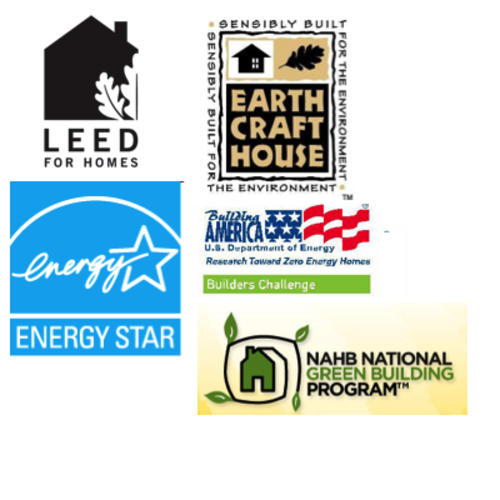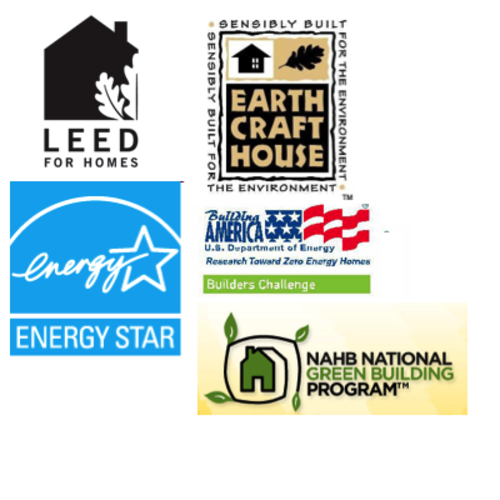
First, a little history
The competition is heating up in the world of green-building certification. Things moved slowly and steadily, starting way back when Austin, Texas put together its local program. With a limited amount of green-home certification available in the late 1990s, the NAHB Research Center set up a project to assist local home builders’ associations in creating their own green building programs. EarthCraft House, based in Atlanta, was one of the first programs developed with the Research Center, and now it has a presence in six Southern states. Since that time, somewhere around 100 local and regional green building programs have come into being.
At the same time, the Energy Star program began making strong inroads in some states of the country, particularly in Texas and Colorado. Other national programs, such as the American Lung Association’s Health House and Masco’s Environments for Living, also appeared, carving out their own shares of the market.
USGBC stakes out its territory
The real fight broke out with the release of LEED for Homes. Backed by the marketing juggernaut of the U.S. Green Building Council (USGBC), LEED for Homes, after a slow start, rolled out as a pilot program in 2005. It was developed with the assistance of several local programs with the promise that LEED would not compete in their local markets. Well, things did not quite turn out that way. LEED is available everywhere and is in fact competing with almost all local programs with varying success.
As LEED began to command a strong public presence, the NAHB, an enormous power in the residential construction industry, developed its own green-building guidelines to provide a framework for local builders’ associations’ green programs.
NAHB enters the ring
NAHB’s stated policy was to support voluntary programs and, specifically, not create its own national program. Then suddenly NAHB looked in the rearview mirror and saw LEED coming up strong behind it, flashing its brights and trying to pass. NAHB, in an abrupt turnaround, created a national program through the Research Center based on its guidelines and began the process of creating the new National Green Building Standard, approved by ANSI this year. NAHB’s national program now has options for builders to certify projects under the new standard as well as the older guidelines, although the latter will ultimately be phased out.
Who will end up as roadkill?
To date there have been approximately 1,400 homes certified under the LEED program and about 150 under NAHB, and both programs are growing steadily. Although these numbers are dwarfed by the tens of thousands that have been certified under local programs and the almost 1 million Energy Star homes, the real fight to watch is between LEED and NAHB, and the effects that they’ll have on all those local programs that literally created the industry while the big guys sat on the sidelines waiting to swoop in and take over.
I will not comment on the relative merits of any one program over another—that is for another post or two, but it will be interesting to watch and also to see which programs are left as roadkill in the process.
Weekly Newsletter
Get building science and energy efficiency advice, plus special offers, in your inbox.















8 Comments
Greentpoint Rated
I'm curious as to how you see the GreenPoint system (developed by BuildItGreen in California) fits into this picture. It is a "local" rating system, but it seems to have gotten a high degree of adoption, including endorsement by the Northern and Central California branches of the NAHB. And California swings enough weight by virtue of its size and economic power that a "local" program could wind up making a splash on the national stage.
HERS
Does the NAHB system use the HERS software?
HERS
The question about NAHB and HERS ratings is a complicated one. If you choose the performance path, you can use a HERS rating to gain points. An option is to choose the prescriptive path, where you do a specified list of items instead of the HERS rating to gain different points. This is similar to Energy Star where you can do the HERS rating or do a list of items. The issue in the NAHB program is that if you choose the performance path and the HERS rating, you don't need to actually test the house with a blower door and duct blaster, if you don't want to. In this case, you use the same software but just enter a designated leakage factor for the building and the ducts. I hope that explains it. Look for upcoming articles that explain both LEED and NAHB in more detail in a few weeks.
Not roadkill, just hopped on the bus
I can see that it is a lot of fun to imagine a "battle of the green giants" out there but I think it's far more productive to keep focused on the fact that we are all of us working towards the same goal of transforming the way we build homes and renovate in America.
Here in North Carolina our Green Builders of the Triangle is one of the ones who are letting go of our old GBI based standard and moving to adopt the new National Green Building Standard. That does not make us "road kill." We just chose to get off one path and onto another. We still have an important role to play bringing green builders and trade partners together for educational presentations and networking and for our spring and fall green home tours. A strong local program is still needed to bring new green builders into the fold and support them with knowledge of what works best and brings the most impact for the dollar in our climate. The NAHB Research Center and University of Housing can only do so much on a national level.
I'm currently certifying my first project to the new NAHB standard and it's bitter sweet because I've been hitting gold under the old Guidelines but under the new National Green Building Standard the owners decision to install a 1.6 GPF toilet in her master bathroom locks me out of gold and relegates me to silver (along with a few other short comings but that is the tipping point.) The new NAHB Standard is a lot tougher than I am used to but still much more flexible than the LEED-h though that has gotten much more reasonable in the newest iteration.
I've been scoring my projects to the LEED-h standard for a while now to see how the programs compare but this time I'm actually going through the full LEED-h certification process in addition to our NC version the old program, the new NAHB Standard, Energy Star, and DOE Builders Challenge. So far it looks like this house will get gold in the local program, silver in the NAHB standard, and certified in the LEED-h standard.
In both LEED-h and NAHB it hurts a lot that I have R-46 dbl-stud exterior walls that are over a foot thick and are counted as interior space which pumps up the calculated size of the home. NAHB rewards me for doing duct calculations, LEED-h disqualifies me if I don't. The house has radiant floor heating with drain-back solar thermal so the duct calculations for the zoned-bypass de-humidification system are undeniably overkill but I had to do them if I want to certify to LEED-h.
I really don't know of nor can I imagine a builder certifying to the NAHB standard without also certifying to Energy Star and running the requisite blower door tests. I think that NAHB left that door open to encourage competition in the third party energy auditing business to keep costs down. Their goal is to bring as many builders into the green building certification game as possible to cut back on green washing by builders who put in bamboo flooring and a geothermal heat pump and call it green. There is no competition here to LEED-h which seeks to recognize the most high performing homes in America.
I often say that LEED-h is the nice brick church on the hillside and NAHB green is the revival tent down on the flood plain. Bring us your un-bathed heathens and let us commence to layin' on of hands! Those of you who have your bible memorized may be more comfortable up on the hill, but you're welcome in the tent 'cause we are all preaching the same religion.
Green Home Verification
Carl,
Interesting food for thought. I am an NAHB Verifier, and my question has historically been the opposite of the one you pose here. That question is will an abundance of green rating programs leave the public confused over which is best? After reading your piece, it will interesting to see if the number of programs increases or decreases and who the "winner" will be. That leads to the next question of if these standards become commonplace, will there be a need to rate green homes?
Great discussion
Michael, you are eloquent as always, must have been an English major. As a lowly art school student, I always struggle with my writing. I agree that LEED and NAHB are going after different sections of the market, something that I will cover more in an article I am currently working on. I understand the frustration with LEED, which with the bar set so high, can exclude some very high performing projects with what can appear as minor justification. On the other hand, NAHB seem to me to be almost too inclusive, I would prefer that their program had set the bar at least a little higher, although I will give them time to make some adjustments as the program evolves, as they all do. I see this as Goldilocks situation - LEED is too hard, NAHB is too soft, and many of the local programs I am familiar with are "just right", both in terms of rigor and administration. LEED and NAHB are both a challenge to manage, in totally different ways. And while EarthCraft and other programs have their problems, they seem to just make more sense to me, as well as many others.
I also understand the need for there to be a consistent message to the general public to avoid confusion in the marketplace and cut down on the "paralysis analysis" that can come from too many choices (ever try to pick out speakers in a stereo shop?). That said, I feel that the local programs have carried the weight of literally creating the industry, only to be looking at their potential demise as the two behemoths (Godzilla and King Kong?) stake out claims to their respective parts of the market. But I guess that is what happens in America. That is why the buggy whip business never came back.
A side note on building size - check on the wall thickness issue, I believe you can measure to the center of a thick wall which will give you a little breathing room on the house size issue. I agree that this criteria is kind of foolish - you build a super efficient house and get penalized for it. Doh!
Grant - to your comment, it is my fervent hope that by the time I am ready to retire that the need for green raters and consultants will be eliminated. Green building as a separate practice should be obsolete - it should be the way everything is done. We will have to wait and see what happens.
As a home buyer, I'd be happy
As a home buyer, I'd be happy to see as many of these programs as possible. I don't mind the competition and they help me make decisions, and the competition is forcing the programs to be clear instead of confusing (LEED=confusing). The ones with guarantees (Environments for Living comes to mind) are especially credible. My expectation is that the programs will interlock, not kill each other off.
Green Point Rating
I am somewhat familiar with the Green Point program, I actually am a CA CGPB. I think it is very typical of many local and regional programs. Based on the power behind LEED and NAHB, it is unlikely that any other programs will gain much momentum on a national level, nor do many of them have aspirations or the funding to do so.
Log in or create an account to post a comment.
Sign up Log in